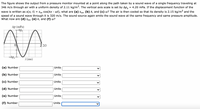Question

Transcribed Image Text:The figure shows the output from a pressure monitor mounted at a point along the path taken by a sound wave of a single frequency traveling at
346 m/s through air with a uniform density of 2.11 kg/m³. The vertical axis scale is set by Apg = 4.20 mPa. If the displacement function of the
wave is written as s(x, t) = Sm cos(kx - wt), what are (a) sm, (b) k, and (c) w? The air is then cooled so that its density is 2.15 kg/m3 and the
speed of a sound wave through it is 320 m/s. The sound source again emits the sound wave at the same frequency and same pressure amplitude.
What now are (d) sm, (e) k, and (f) w?
Ap (mPa)
Aps
2.10
t (ms)
(a) Number
Units
(b) Number
Units
(c) Number
Units
(d) Number
Units
(e) Number
Units
(f) Number
Units
Expert Solution
arrow_forward
Step 1
Hello. Since your question has multiple sub-parts, we will solve the first three sub-parts for you. If you want remaining sub-parts to be solved, then please resubmit the whole question and specify those sub-parts you want us to solve.
(a)
Let f denotes the frequency of the wave and T denotes the time period. Therefore, the frequency of the wave can be determined as,

Trending nowThis is a popular solution!
Step by stepSolved in 4 steps with 4 images

Knowledge Booster
Similar questions
- Please asaparrow_forwardLoudness (L), in decibles (dB), of a sound of intensity I is defined to be L=10log( I/I0), where I0=10-12(W/M2) (watts per meter square) is the minimum intensity detectable by the human ear. A.) Find the loudness L, in decibles (dB), of a trombone given the intensity is 1010I0 B.) Find the intensity of a rock concert whose loudness is 115 decibles. C.) What is the NIOSH recommended Exposure Limit (REL) given in dB based on exposures at work 5 days per week?arrow_forwardA progressive wave travelling in the x-direction is represented by the following equation: y = Asin(Bt - Cx). Given that parameters A, B and Care given in Sl units calculate the velocity of the wave for A = 50, B = 2694 and C = 21.arrow_forward
- A bat can detect small objects, such as an insect, whose size is approximately equal to one wavelength of the sound the bat makes. If bats emit a chirp at a frequency of 64.0 kHz, and if the speed of sound in air is 340 m/s, what is the smallest insect a bat can detect?arrow_forwardWhat is the speed of sound in substance X if a note produced at 440Hz has a wavelength of 14.8 m?arrow_forwardA bat emits a sound whose frequency is 81.8 kHz. The speed of sound in air at 20.0 oC is 343 m/s. However, the air temperature is 41.8 oC, so the speed of sound is not 343 m/s. Assume that air behaves like an ideal gas, and find the wavelength of the sound.arrow_forward
- We will assume that a sound wave, once generated and emitted, will propagate uniformly in all directions of 3-dimensional space. Find an expression for the displacement s(r, t) of the air particles from equilibrium, where r is the radial distance from the source, and t is time. Introduce physical constants/coefficients, with appropriate physical dimensions, when necessary.arrow_forwardThe function y(x, t) = A cos(kx - wt) describes a traveling wave on a taut string with the x-axis parallel to the string. If the wavelength of the wave λ = 0.8 m and w = 17.1л/s, what is the speed of the traveling wave? Express your answer in m/s, to at least one digit after the decimal point.arrow_forwardThe human ear can detect a minimum intensity of Io = 10-12 W/m2, which has a sound intensity of 0 dB.Randomized Variablesβ = 35 dB If the student hears a sound at 35 dB, what is the intensity of the sound?arrow_forward
arrow_back_ios
arrow_forward_ios